Lothrop Stoddard (1883-1950) was, in many respects, decidedly a man of his times. Like many intellectuals of his generation, he devoted the bulk of his writing to the nascent field of social science, hoping to harness the discipline not only to explain the past and present, but also to affect positive changes in the future. He can accurately be surmised as a disciple of Madison Grant, who was himself the intellectual progeny of Arthur de Gobineau by way of Houston Stewart Chamberlain. The Rising Tide of Color [2], the 1920 geopolitical and anthropological work for which Stoddard was and is best known, shows Grant’s influence not only in its division of the Aryan race into three subcategories (Nordic, Alpine, and Mediterranean), but also in its overriding pessimism and anxiety about the future of white civilization, a trait characteristic of the post-First World War generation of Right-wing intellectuals.
 However, Stoddard departed from Grant in meaningful ways and, while some of Grant’s work is commendable, Stoddard’s deviations from it are almost uniformly for the better. In The Passing of the Great Race [3], Grant suggested that the Nordic race was characterized by a set of sublime, masterful traits which were absent from lesser races, including the other Caucasoid races. Stoddard, by contrast, is less interested with these subdivisions than with the fate of the larger racial community. Grant wrote the preface to The Rising Tide of Color, and the word “Nordic” appears far more often in those thirty-two pages than in the remaining three-hundred some pages of the book. As one would expect, Stoddard is guilty of some of the purity-spiraling which characterized his generation of racial theorists and remains a problem for white activism today, but these forays into excess are easy to overlook in favor of the more relevant argument and his obvious admiration for a greater racial community.
However, Stoddard departed from Grant in meaningful ways and, while some of Grant’s work is commendable, Stoddard’s deviations from it are almost uniformly for the better. In The Passing of the Great Race [3], Grant suggested that the Nordic race was characterized by a set of sublime, masterful traits which were absent from lesser races, including the other Caucasoid races. Stoddard, by contrast, is less interested with these subdivisions than with the fate of the larger racial community. Grant wrote the preface to The Rising Tide of Color, and the word “Nordic” appears far more often in those thirty-two pages than in the remaining three-hundred some pages of the book. As one would expect, Stoddard is guilty of some of the purity-spiraling which characterized his generation of racial theorists and remains a problem for white activism today, but these forays into excess are easy to overlook in favor of the more relevant argument and his obvious admiration for a greater racial community.
Stoddard has some positive things to say about non-white races, even as he views geopolitical circumstances naturally drawing them into conflict with whites. For instance, Stoddard praises the Chinese for their laboriousness. The Japanese are praised for their rapid industrialization, and the West is chastised for having underestimated their abilities. Stoddard even praises the Islamic Revival as regenerative within its particular cultural context, restoring to the Arab world a vitality which had been lost within the bureaucratic Ottoman Empire, and he portrays Arabs as some of the world’s fiercest warriors. Stoddard’s advocacy of racial hygiene thus has the goal of preserving the distinctive traits of all races, not just a particular subset of the Caucasoid race. In this sense, he has more in common with many on the New Right than does Madison Grant.
In The Rising Tide of Color, Stoddard made a number of predictions which have proven startlingly accurate, if not wholly original. Stoddard’s thesis, in essence, is that the apparent hegemony of Europe in his day would be short lived – white civilization would soon be overrun by the “colored” races. Unsurprisingly, he does not predict that this circumstance will be brought about by non-whites overtaking whites in terms of ability. Rather, this usurpation of the West would be a simple metric of quantity over quality, the result of higher birth rates among non-whites. These higher birth rates, he notes ironically, would not be possible without the medicinal, technological, and political changes brought to Africa and Asia by European colonists. At stake here was not just the displacement of whites from their traditional homelands. Stoddard, who had previously written The French Revolution in San Domingo, was well aware of the probable fate of white minorities. The dysgenic tragedy of the First World War, which Stoddard aptly portrayed as meaningless but unfairly blames almost exclusively on the Germans, is portrayed as accelerating the onset of this catastrophe.
 Stoddard foresaw that capitalism would encourage the importation of non-white labor that would outcompete whites not in its quality, but in its quantity and its willingness to work for practically nothing. This willingness is owed to the fact that, given the Malthusian pressures triggered by the overpopulation of their nations, even the most meager subsistence would be preferable from their perspective. Needless to say, this prediction has been made manifest in the United States, the United Kingdom, Germany, and elsewhere. Stoddard predicted that the Islamic Revival would bring the Muslim world into war against the West and that black Africans would align with Muslims in this effort. Stoddard predicted that internecine rivalries between non-whites would be put aside in favor of a sort-of rainbow coalition that would persist up until the moment that the white world had been defeated. He also predicted that the moral grandstanding about national self-determination during and after the First World War would make continued maintenance of the massive European colonial empires an impossibility. This seems obvious in retrospect – the values codified at Versailles both incentivized the creation of nationalist movements across the European colonies and made the ruling position blatantly and indefensibly hypocritical – but it must not have been to the contemporary British and French ruling class, who made efforts (with varying degrees of intensity) to cling to their empires into the 1960s. He predicted that the Bolsheviks would persuade discontented colored nationalists to the cause of Communism. He predicted that Japan would challenge the West for hegemony over Asia – another accurate prediction, although its impressiveness is mitigated by the fact that this was already a widespread belief following the Russo-Japanese War of 1904-05. He also presaged Samuel Huntington by prophesying that the struggle between various races and cultures, rather than Marxist materialist concerns, would be the primary cause of conflict and consciousness in the twentieth century and beyond.
Stoddard foresaw that capitalism would encourage the importation of non-white labor that would outcompete whites not in its quality, but in its quantity and its willingness to work for practically nothing. This willingness is owed to the fact that, given the Malthusian pressures triggered by the overpopulation of their nations, even the most meager subsistence would be preferable from their perspective. Needless to say, this prediction has been made manifest in the United States, the United Kingdom, Germany, and elsewhere. Stoddard predicted that the Islamic Revival would bring the Muslim world into war against the West and that black Africans would align with Muslims in this effort. Stoddard predicted that internecine rivalries between non-whites would be put aside in favor of a sort-of rainbow coalition that would persist up until the moment that the white world had been defeated. He also predicted that the moral grandstanding about national self-determination during and after the First World War would make continued maintenance of the massive European colonial empires an impossibility. This seems obvious in retrospect – the values codified at Versailles both incentivized the creation of nationalist movements across the European colonies and made the ruling position blatantly and indefensibly hypocritical – but it must not have been to the contemporary British and French ruling class, who made efforts (with varying degrees of intensity) to cling to their empires into the 1960s. He predicted that the Bolsheviks would persuade discontented colored nationalists to the cause of Communism. He predicted that Japan would challenge the West for hegemony over Asia – another accurate prediction, although its impressiveness is mitigated by the fact that this was already a widespread belief following the Russo-Japanese War of 1904-05. He also presaged Samuel Huntington by prophesying that the struggle between various races and cultures, rather than Marxist materialist concerns, would be the primary cause of conflict and consciousness in the twentieth century and beyond.
The Rising Tide of Color was well-received, despite being panned by the eminent anthropologist Franz Boas, who (in keeping with his Jewishness) was endeavoring to remove all racial considerations from a field historically composed almost exclusively of racial studies. Stoddard took the implications of his research seriously, and worked to prevent the catastrophe he foresaw from becoming a reality. To this end, he helped lobby for the 1924 Johnson-Reed Act, much admired by contemporary and modern Rightists, which created an immigration system based upon quotas designed to preserve the traditional ethnic makeup of the United States. This seems to have alleviated much of his pessimism, as his 1927 book Re-forging America: The Story of Our Nationhood [4] celebrates the (sadly, illusory) palingenesis of the US and its founding stock. Reflecting the non-racial dysgenic concerns described within The Revolt Against Civilization: The Menace of the Underman [4] (1922), Stoddard helped promote eugenicist policies, working alongside Margaret Sanger to create the birth control movement. He also spent time as a correspondent in the Third Reich, of which he held an ambivalent view. Nonetheless, German government officials naturally preferred giving interviews to Stoddard rather than to the more hostile William Shirer. During and after the Second World War, Stoddard, like many of his generation, was shut out from even supposedly conservative publications. The man and his work were suddenly heretical to the intellectual and political establishment, and he was silenced to such an extent that his death in 1950 went practically unreported in the press.
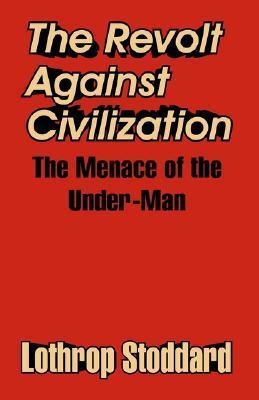 Today, the unfortunate veracity of Stoddard’s predictions has reignited interest in his scholarship, sympathetically in dissident circles and, of course, negatively in the establishment. The similarity of his predictions to the “Great Replacement” which we observe today will not be lost on any conscious reader. It is safe to say that this is the reason that Stoddard has recently begun reappearing in Leftist publications. The Left uses Stoddard [5] to demonstrate that anything but an open border is racist and evil, and those articles are exactly the kind of insipid, smooth-brained commentary you would expect – in essence, Stoddard proves that “orange man bad.” Another article positions Stoddard as evidence for the dangers of academic and speech freedoms [6]. A slightly (but only slightly) more interesting article suggests that Douglas Murray is the heir apparent to Stoddard’s legacy [7], a somewhat accurate assessment nonetheless muddled by the asinine, copy-and-paste commentary suggesting that the displacement of whites is at once a ridiculous conspiracy theory and an inevitable force of nature that we should celebrate and embrace. The establishment Right [8] has also recently begun smacking around Stoddard, using him to tar Planned Parenthood as part of its ridiculously misguided and self-destructive campaign against abortion rights.
Today, the unfortunate veracity of Stoddard’s predictions has reignited interest in his scholarship, sympathetically in dissident circles and, of course, negatively in the establishment. The similarity of his predictions to the “Great Replacement” which we observe today will not be lost on any conscious reader. It is safe to say that this is the reason that Stoddard has recently begun reappearing in Leftist publications. The Left uses Stoddard [5] to demonstrate that anything but an open border is racist and evil, and those articles are exactly the kind of insipid, smooth-brained commentary you would expect – in essence, Stoddard proves that “orange man bad.” Another article positions Stoddard as evidence for the dangers of academic and speech freedoms [6]. A slightly (but only slightly) more interesting article suggests that Douglas Murray is the heir apparent to Stoddard’s legacy [7], a somewhat accurate assessment nonetheless muddled by the asinine, copy-and-paste commentary suggesting that the displacement of whites is at once a ridiculous conspiracy theory and an inevitable force of nature that we should celebrate and embrace. The establishment Right [8] has also recently begun smacking around Stoddard, using him to tar Planned Parenthood as part of its ridiculously misguided and self-destructive campaign against abortion rights.
It will doubtless be a shock to all Counter-Currents readers to learn that none of this mainstream pabulum is worth the time invested in reading it. However, there has been one recent article regarding Stoddard which caught my attention and which, through its enshrinement in Stoddard’s Wikipedia entry, has now become part of his popular legacy. The article, published in The New Yorker and penned by Ian Frazier, regrettably grabbed my attention with the clickbait headline “When W. E. B. Du Bois Made a Laughingstock of a White Supremacist [9].” I immediately knew, based on the fact that he had once engaged in a public debate with Du Bois, that the eponymous “supremacist” was Stoddard. Moreover, I immediately knew that the article must be laughably disingenuous, given that Du Bois was not remotely close to Stoddard in terms of ability (and given that it was published in The New Yorker). Du Bois is a beloved icon of the modern American Left, a fact attributable to his blackness, his constant demands that whites change their societies to include and advance blacks, and his Marxism.
Du Bois is uniformly portrayed as an inimitable genius, rivaled only by Emile Durkheim and Franz Boas as a founder of social science. However, when one actually examines his ideas, it becomes obvious that not only was he wrong about practically everything but, worse, he also had nothing novel to say. Every single one of Du Bois’ supposed contributions to social science can more meaningfully be attributed to someone else. The term “color line” to describe racial segregation was coined by Frederick Douglass (and, at any rate, is hardly an insight), and the argument that the concept of race only exists to justify capitalist exploitation was clearly lifted from Karl Marx’s theories of superstructure and false consciousness. Du Bois’ most celebrated achievement, elucidated in The Souls of Black Folk, is the theory of “Double Consciousness,” wherein blacks are forced to consider themselves through white racial conceptions. Even this is lifted from elsewhere, little more than a modified version of Ralph Waldo Emerson’s concept of the same name. Moreover, double consciousness’ claim that black Americans are forced to inexorably struggle to reconcile a black ethnocultural identity with their existence in a European cultural context has always struck me as a direct contradiction of Du Bois’ race negationism. Race, when it is conceived by whites, is a social construct created to justify exploitation. When conceived by blacks, race is an innate reality of existence, and Pan-African cultural traits persist within the black soul regardless of their physical location.
Nonetheless, and despite the much more numerous successes of his arch-rival Booker T. Washington, Du Bois was regarded as the leading black intellectual of his day. In The Rising Tide of Color, Stoddard had explicitly cited Du Bois as an example of the growing non-white resentment that would undermine and eventually destroy white civilization. This, coupled with Stoddard’s constant willingness to express his ideas in front of even uniformly hostile audiences (he even gave a speech to all-black Tuskegee University in 1926), led to a 1929 debate between Stoddard and Du Bois in Chicago. The debate was Du Bois’ brainchild, and was thus held in front of a largely black audience and reported on primarily by the black press. One is thus forced to wonder what Stoddard thought this debate would accomplish. At the time, there remained some slight degree of optimism that blacks and whites would both remain in their proverbial lanes, with blacks following the example of Booker T. Washington and his Atlanta Compromise. Indeed, Stoddard referenced Washington’s metaphor of the American races as a hand (in which each race is kept distinct, like the fingers, but works together for the betterment of all) during the debate. But Washington’s path, which focused on black self-improvement, cultural assimilation, and interracial cooperation until black-white parity was achieved, was always a longshot; it required blacks to possess low time preference. Du Bois’ way – simply demanding that white society change to fit black expectations by appealing to the white sense of fair play and benevolence – was always going to be an easier sell.
To borrow a beloved Leftist expression, everything about the debate was “rigged.” The New Yorker article, like the magazine’s Jewish readership and the debate’s contemporary audience, has of course already made up its mind on who won the debate before a single word is relayed. Author Ian Frazier mocks Stoddard as a “nut,” citing his belief in “germ-plasm” as the conveyor of genetic information. Stoddard’s understanding of this process retrospectively comes across as nonsense, and The New Yorker clearly feels that it is no excuse that he was writing at a time when no one on Earth understood it much better. Likewise, the black correspondents who recorded the details of the event from which we are to draw our conclusions represented The Chicago Defender, which had called Stoddard “the high priest of racial baloney,” and The Baltimore Afro-American, which had at once rejected the premise of The Rising Tide of Color while simultaneously celebrating its statistics showing that non-white people outnumbered whites worldwide.
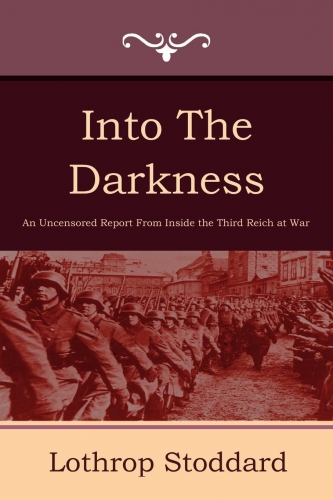 The central question of the debate was “Shall the Negro Be Encouraged to Seek Cultural Equality?,” a concept which had never been relevant to Stoddard’s research but was the entire raison d’etre for Du Bois’ career. Moreover, the framing of the question was such that, even at the time, it would have been impossible to make a cogent argument against it. The contrary position, that whites should actively discourage blacks from bettering themselves, would not have been how segregationists presented their position. And, of course, Du Bois was not asking for whites to “encourage” blacks to “seek” their own achievements – that was the position of Booker T. Washington, his hated nemesis. Du Bois’ goal was to dissolve white institutions, or at least inject blacks into them, and to accomplish a Marxist redistribution of wealth along racial lines.
The central question of the debate was “Shall the Negro Be Encouraged to Seek Cultural Equality?,” a concept which had never been relevant to Stoddard’s research but was the entire raison d’etre for Du Bois’ career. Moreover, the framing of the question was such that, even at the time, it would have been impossible to make a cogent argument against it. The contrary position, that whites should actively discourage blacks from bettering themselves, would not have been how segregationists presented their position. And, of course, Du Bois was not asking for whites to “encourage” blacks to “seek” their own achievements – that was the position of Booker T. Washington, his hated nemesis. Du Bois’ goal was to dissolve white institutions, or at least inject blacks into them, and to accomplish a Marxist redistribution of wealth along racial lines.
The debate began with the moderator presenting Du Bois as “one of the ablest speakers for his race not only in America but in the whole wide world,” while Stoddard was “a man whose books and writings and speaking have made his views known to many hundreds of thousands of people both in this country and abroad.” In other words, Du Bois is among the most brilliant people in the world, and Stoddard is someone who is literate enough to convey his ideas through the written word. Du Bois’ speech at the debate was typical for him and the precedent of black activism he established: He argues that everyone should be given cultural equality freely rather than having to seek or earn it, that since Abolition blacks have a list of accomplishments with “few parallels in human history” (though what these are is not stated), and that the white race has actually done far more ill for the world than good. Nordic whites, he says, have inflicted war, suffering, and tyranny on more people than any other group, a position that could be found restated verbatim in any modern Leftist publication. The same could be said of his next argument, which is that science (in the abstract) has proven that the races are equal in their aptitudes.
Du Bois also says that Stoddard is hypocritical for opposing miscegenation, for it is whites that have brought about the majority of interracial interaction in the world via exploration and colonization. Moreover, it is only arrogance which leads whites to believe that blacks would want to copulate with them in the first place. In the very next breath, Du Bois asserts that racial categorization itself is ridiculous because, as a mixed-race person himself, he is both Nordic and negro. This obvious contradiction – wherein he chastises whites for miscegenation before immediately saying resisting miscegenation is foolish – gets no commentary from The New Yorker, which presents Du Bois’ argument as brilliant at every turn, carefully luring Stoddard into a rhetorical trap. Du Bois finishes by saying that the US is founded upon Christian values, which it betrays by denying equality to blacks; in essence, that “this is not who we are.” What is most striking about Du Bois’ speech is that it reveals that the Left simply never changes. Their rhetoric today is the very same as it was ninety years ago. While it has never ceased being emotionally manipulative and intellectually bankrupt, you can hardly blame Leftists for sticking to a script which has won them a practically uninterrupted string of major victories.
Stoddard, for his part, does not even address Du Bois’ points. His proposal is the maintenance of the “separate but equal” dictum established by Plessy v. Ferguson, in which the races are kept apart not based on claims of superiority, but simply on the basis of racial difference. The New Yorker predictably presents this as a distortion of his beliefs, but I have little doubt that Ian Frazier never read The Rising Tide of Color, which makes the same essential argument. This brings us to the climactic moment of the debate when, as The New Yorker tells it, Du Bois makes a laughingstock of Stoddard, exposing his “unintentionally funny” ideas for just how ridiculous they are. Let us see how Du Bois’ brilliant dialectical style unfurled in full flower, ensnaring this hapless, “Nazi-loving” fool in its wake.
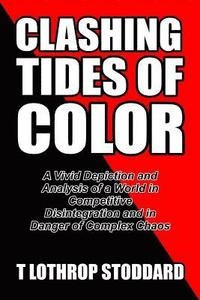 Stoddard says that “the more enlightened men of southern white America” are trying to ensure that, while the races are kept separate, that the facilities to which they have access are nonetheless equal in quality. This elicited laughter from the black audience, who found the claim to be ridiculous. Stoddard then informed them that he did not see the joke, apparently eliciting more whooping. Angered, Stoddard rebutted that bi-racial cooperation of the Atlanta Compromise mold was making more progress than anything Du Bois was attempting – another apt prediction, for Du Bois died having accomplished none of his goals. Du Bois gave up on “progress” in the US and eventually moved to observe and admire Mao Zedong’s brutality in China before settling in Ghana. His NAACP was and remains little more than a debating and protesting society. From its inception in 1909, the NAACP incessantly complained for over fifty years until other acronymous black organizations, aided by the bayonets of the National Guard and the Cold War exigencies of “winning hearts and minds,” ended the white near-monopoly on American political power.
Stoddard says that “the more enlightened men of southern white America” are trying to ensure that, while the races are kept separate, that the facilities to which they have access are nonetheless equal in quality. This elicited laughter from the black audience, who found the claim to be ridiculous. Stoddard then informed them that he did not see the joke, apparently eliciting more whooping. Angered, Stoddard rebutted that bi-racial cooperation of the Atlanta Compromise mold was making more progress than anything Du Bois was attempting – another apt prediction, for Du Bois died having accomplished none of his goals. Du Bois gave up on “progress” in the US and eventually moved to observe and admire Mao Zedong’s brutality in China before settling in Ghana. His NAACP was and remains little more than a debating and protesting society. From its inception in 1909, the NAACP incessantly complained for over fifty years until other acronymous black organizations, aided by the bayonets of the National Guard and the Cold War exigencies of “winning hearts and minds,” ended the white near-monopoly on American political power.
The duplicity of The New Yorker’s portrayal here is so obvious that I have to imagine even those few goyim foolish enough to regularly sift through its wretched pages were able to at least sense a slight tingling in their temporal lobe. Clearly, Du Bois did nothing to “make a laughingstock” of Stoddard. Stoddard simply stated his beliefs in front of an audience so hostile to them that they met his arguments with incredulous laughter. The same result would befall anyone today who attempted to suggest before a black audience that Affirmative Action is racially biased or that Michael Brown was not a gentle giant. One wonders what the response would have been if Du Bois had returned Stoddard’s courtesy by conducting a debate in front of an educated, pro-white audience. How might they have reacted if Du Bois had made his claim that science disproves human genetic variation?
Ironically, the 2019 retrospective on this debate in The New Yorker is evidence of the veracity of Stoddard’s ideas. The entire informational apparatus of the US has been seized by vengeful non-whites and their self-destructive white allies, and is now used as a vanguard for affecting anti-white sociopolitical change. The rest of society is already taking and will continue to take the same course as whites become an increasingly scarce minority. Barring a miracle reversal, the “rising tide” which he feared and helped delay will subsume whites, subjecting them to the conditions which have befallen white minorities everywhere around the world.





 del.icio.us
del.icio.us
 Digg
Digg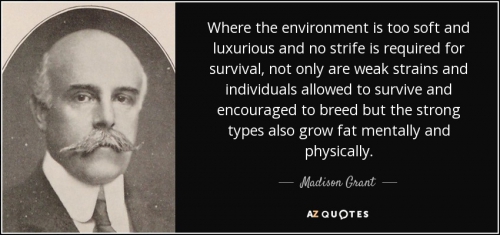
 Certainly, something like the National Socialist regime in Germany did have eugenics programs. They were not actually as pronounced as some might believe. They actually modeled a lot of those programs on the eugenics programs found in Sweden and in the state of California. California was probably the ultimate model. You had eugenics being endorsed by university presidents. That is, it was very much endorsed by the elite. They thought this was a good thing and it was also a part of the progressive elite. Eugenics was not a reactionary opinion. It was something that was opposed by the old time religion folks or whom you might call reactionaries. It was something that might even be on the Left in certain contexts. Certainly, with somebody like Lothrop Stoddard, who we’re going to speak about a little bit later, it was a position held by someone who openly thought of himself as a progressive and a modernist. And it also had some popular appeal. Actually, in a talk I gave not too long ago at the H. L. Mencken Club, I showed some pictures that were actually taken by a very good book, a biography of Lothrop Stoddard which was written by a Left-liberal who doesn’t like Stoddard very much but recognizes his importance, but these pictures were of eugenic buildings at the state fair. I believe a famous one was from the Kansas State Fair. They would have a competition for the fittest family, and what they wanted to see was a good genotype. That was a healthy family with all boys and girls looking strong and smart and good-looking parents and things like this. So, eugenics really had a positive value in peoples’ lives. It was something that meant that they were healthy and good and normal and people of quality. Obviously, this has gone through a total reversal.
Certainly, something like the National Socialist regime in Germany did have eugenics programs. They were not actually as pronounced as some might believe. They actually modeled a lot of those programs on the eugenics programs found in Sweden and in the state of California. California was probably the ultimate model. You had eugenics being endorsed by university presidents. That is, it was very much endorsed by the elite. They thought this was a good thing and it was also a part of the progressive elite. Eugenics was not a reactionary opinion. It was something that was opposed by the old time religion folks or whom you might call reactionaries. It was something that might even be on the Left in certain contexts. Certainly, with somebody like Lothrop Stoddard, who we’re going to speak about a little bit later, it was a position held by someone who openly thought of himself as a progressive and a modernist. And it also had some popular appeal. Actually, in a talk I gave not too long ago at the H. L. Mencken Club, I showed some pictures that were actually taken by a very good book, a biography of Lothrop Stoddard which was written by a Left-liberal who doesn’t like Stoddard very much but recognizes his importance, but these pictures were of eugenic buildings at the state fair. I believe a famous one was from the Kansas State Fair. They would have a competition for the fittest family, and what they wanted to see was a good genotype. That was a healthy family with all boys and girls looking strong and smart and good-looking parents and things like this. So, eugenics really had a positive value in peoples’ lives. It was something that meant that they were healthy and good and normal and people of quality. Obviously, this has gone through a total reversal. So, you have a reversal of what went on and at times an unstated reversal whereby the policies just change. The sterilization of people with grossly deformed and inadequate IQs, for example, to prevent them from breeding people who might be described as “idiots” in future, sort of percussive generations. That came to an end in most Western countries around the same time in the mid-1970s, and I think it came to an end because generationally the scientists who’d imbibed eugenic ideas had essentially passed through the system and were retiring and being replaced by a cohort who didn’t share the same notions.
So, you have a reversal of what went on and at times an unstated reversal whereby the policies just change. The sterilization of people with grossly deformed and inadequate IQs, for example, to prevent them from breeding people who might be described as “idiots” in future, sort of percussive generations. That came to an end in most Western countries around the same time in the mid-1970s, and I think it came to an end because generationally the scientists who’d imbibed eugenic ideas had essentially passed through the system and were retiring and being replaced by a cohort who didn’t share the same notions.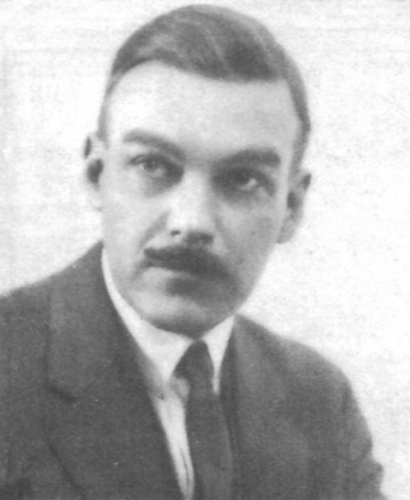 He was part of the Save the Redwoods League. Redwoods, of course, these massive trees, mostly in California. Again, we shouldn’t forget what still exists today for us to appreciate and what probably wouldn’t exist without the work of Madison Grant and his colleagues.
He was part of the Save the Redwoods League. Redwoods, of course, these massive trees, mostly in California. Again, we shouldn’t forget what still exists today for us to appreciate and what probably wouldn’t exist without the work of Madison Grant and his colleagues.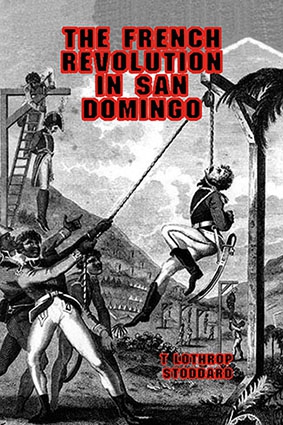 The French Revolution in San Domingo by Stoddard dealt with the immediate aftermath of the French Revolution’s impact on Haiti and the tripartite war that developed between the British crown and the Spanish and French authorities there and the emergence of a racially-conscious Black army under Toussaint Louverture and its aftermath in Haiti when Louverture was outmaneuvered by Napoleon, who as history records of course was a racialist which rather shocks people today. When Toussaint was invited to France he was promptly arrested and put in a tower and Napoleon turned to his marshals and said, “You see how I deal with them?”
The French Revolution in San Domingo by Stoddard dealt with the immediate aftermath of the French Revolution’s impact on Haiti and the tripartite war that developed between the British crown and the Spanish and French authorities there and the emergence of a racially-conscious Black army under Toussaint Louverture and its aftermath in Haiti when Louverture was outmaneuvered by Napoleon, who as history records of course was a racialist which rather shocks people today. When Toussaint was invited to France he was promptly arrested and put in a tower and Napoleon turned to his marshals and said, “You see how I deal with them?” RS: Yes, one thing that I found quite interesting about his book, which I actually read recently because Alex put out a new edition, was the combination between let’s say Leftist ideology, on one hand, and then genetics and biology on the other. One thing you got from the book is that this pot was simmering for a long time. There was always going to be this racial clash. It was never going to ultimately work. It was going to end in tears and blood. But what really set off the revolution, the catalyst, was this new way of talking that was brought to the island immediately after the French Revolution. That you could soon start talking about the “rights of man” and so on and so forth and that this was like pouring gasoline on the fire, and it almost immediately set off a revolution and a race war on the island.
RS: Yes, one thing that I found quite interesting about his book, which I actually read recently because Alex put out a new edition, was the combination between let’s say Leftist ideology, on one hand, and then genetics and biology on the other. One thing you got from the book is that this pot was simmering for a long time. There was always going to be this racial clash. It was never going to ultimately work. It was going to end in tears and blood. But what really set off the revolution, the catalyst, was this new way of talking that was brought to the island immediately after the French Revolution. That you could soon start talking about the “rights of man” and so on and so forth and that this was like pouring gasoline on the fire, and it almost immediately set off a revolution and a race war on the island.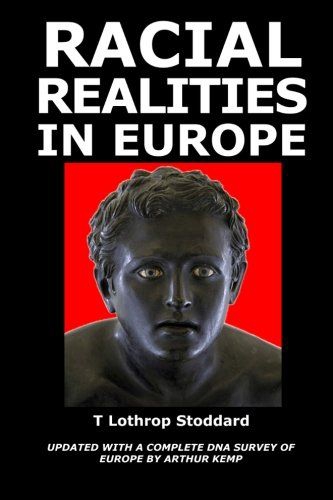 Nevertheless, certain more moderate deep green ideas are deeply susceptible to a Right-wing coinage. The conservation of all forms of natural beauty, extreme forms of localism, forms of animal husbandry that are linked to preservation of animal species and biodiversity but are not linked to doctrines of rights and animal rights or animal liberation but draw on a similar metaphysic but end in a different place because it begins in one. You see this very much, say, with the split in Britain between a sort of anarchist group like the Animal Liberation Front and a conservationist group like the Royal Society for the Prevention of Cruelty to Animals. The two sort of overlap in terms of some of their coteries, but ideologically they’re very much at variance because the one is conservative, small c, and ameliorative and piece-by-piece and localist, whereas the other wishes to extend the universal doctrine of human rights to animal species and has developed a concept of animal racism, of course, namely speciesism. All of which is an outgrowth of the politics of human rights. But if one eschews the politics of human rights in a grandstanding and universalist way and sees human identity and glory in very much an individual or localized manner then deep green and ecological ideas have a lot to say to all forms of conservativism that wish to preserve and restore as against that which is transitory and that which is to our end and which is purely and only concerned with human life to the detriment of the ecology without which mankind couldn’t subsist.
Nevertheless, certain more moderate deep green ideas are deeply susceptible to a Right-wing coinage. The conservation of all forms of natural beauty, extreme forms of localism, forms of animal husbandry that are linked to preservation of animal species and biodiversity but are not linked to doctrines of rights and animal rights or animal liberation but draw on a similar metaphysic but end in a different place because it begins in one. You see this very much, say, with the split in Britain between a sort of anarchist group like the Animal Liberation Front and a conservationist group like the Royal Society for the Prevention of Cruelty to Animals. The two sort of overlap in terms of some of their coteries, but ideologically they’re very much at variance because the one is conservative, small c, and ameliorative and piece-by-piece and localist, whereas the other wishes to extend the universal doctrine of human rights to animal species and has developed a concept of animal racism, of course, namely speciesism. All of which is an outgrowth of the politics of human rights. But if one eschews the politics of human rights in a grandstanding and universalist way and sees human identity and glory in very much an individual or localized manner then deep green and ecological ideas have a lot to say to all forms of conservativism that wish to preserve and restore as against that which is transitory and that which is to our end and which is purely and only concerned with human life to the detriment of the ecology without which mankind couldn’t subsist.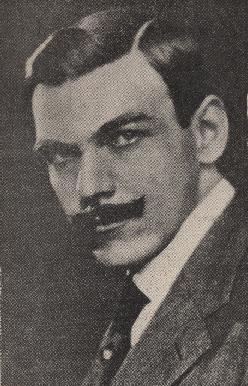 Everyone accepts that it’s OK to read great thinkers of the past, like
Everyone accepts that it’s OK to read great thinkers of the past, like  Stoddard was not, as liberal critics like to
Stoddard was not, as liberal critics like to  Let’s look at some key passages from Stoddard’s magnum opus of 1920,
Let’s look at some key passages from Stoddard’s magnum opus of 1920,  Stoddard wrote more about Islam in his book
Stoddard wrote more about Islam in his book 
 Stoddard was the archetypical product of ivy-league education in the old United States. He graduated magna cum laude from Harvard University, studied law at Boston University, and obtained a PhD in history from Harvard University, later published as the aforementioned book on San Domingo (Haiti).
Stoddard was the archetypical product of ivy-league education in the old United States. He graduated magna cum laude from Harvard University, studied law at Boston University, and obtained a PhD in history from Harvard University, later published as the aforementioned book on San Domingo (Haiti).  But, while socially conservative, he was in every other sense a progressive liberal, strange as that may seem today: for him, eugenics was about improving the efficiency of human society—an aspiration well in keeping with the ideals of the Progressive Age in America, which was all about efficiency, wholesomeness, and purification (something not unrelated to Protestant ideals), and well in keeping with today's progressives, even if their approach is very different. Indeed, eugenics at this time (which was a generation or more before it fell into disrepute) was seen by its proponents as humane, and American writers made their case in terms of '
But, while socially conservative, he was in every other sense a progressive liberal, strange as that may seem today: for him, eugenics was about improving the efficiency of human society—an aspiration well in keeping with the ideals of the Progressive Age in America, which was all about efficiency, wholesomeness, and purification (something not unrelated to Protestant ideals), and well in keeping with today's progressives, even if their approach is very different. Indeed, eugenics at this time (which was a generation or more before it fell into disrepute) was seen by its proponents as humane, and American writers made their case in terms of '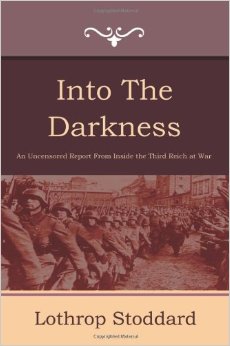 Unfortunately for Stoddard, his investigation of conditions in Germany in the Winter of 1939 - 194o, which resulted in the book Into the Darkness: Nazi Germany Today, proved disastrous for his career. As a journalistic exercise, it made perfect sense: it was topical and controversial. In the heat of the war, however, his theories came to be seen as too closely aligned with those of the National Socialists. By the time he died in 1950, his passing went unnoticed.
Unfortunately for Stoddard, his investigation of conditions in Germany in the Winter of 1939 - 194o, which resulted in the book Into the Darkness: Nazi Germany Today, proved disastrous for his career. As a journalistic exercise, it made perfect sense: it was topical and controversial. In the heat of the war, however, his theories came to be seen as too closely aligned with those of the National Socialists. By the time he died in 1950, his passing went unnoticed.